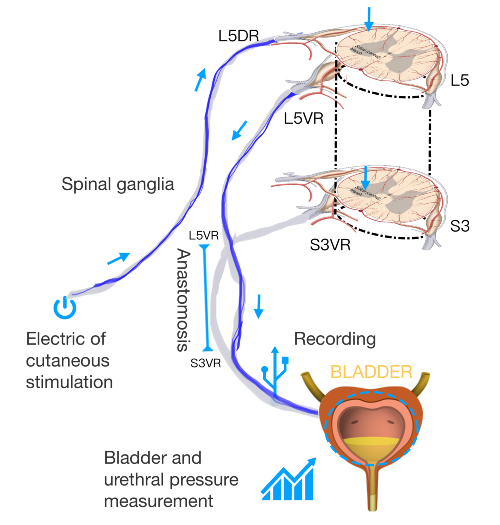The Only Place in the World That Cures Neurogenic Bladder
Xiao Chuan-Guo Hospital


Xiao Chuan-Guo Hospital’s Xiao Procedure effectively addresses a Range of Symptoms in Patients with Spina Bifida / Myelomeningocele
Performing the Xiao procedure on patients with Spina Bifida / Myelomeningocele yields the following results: Connecting a quarter of the lower limb motor nerves with visceral nerves that regulate bladder voiding to establish a new voiding pathway. When the new nerves have grown and developed sufficiently, the brain can independently control urinary and bowel functions.



Addressing Neurogenic Bladder in Spina Bifida via the Xiao Procedure
Every year, 200,000 babies worldwide are born with spina bifida, including 2,758 cases in the U.S. Globally, around 3 million people live with the condition. The Spina Bifida Association estimates that about 70,000 people in the United States have spina bifida[1]. Neurogenic bladder is common in these children, affecting up to 98% with myelomeningocele.
The Xiao procedure utilizes safe and effective nerve anastomosis techniques to address fecal and urinary incontinence in individuals with spina bifida, enabling them to fully reintegrate into normal life.
Proven Success
Despite common disbelief among patients and doctors, why not give our world’s exclusive, proven cure for Spina Bifida a try? With over 3,000 successful cases, the results speak for themselves.
Transform Your Life
Our advanced medical treatments can effectively manage and cure Spina Bifida, transforming thousands of lives—don’t let skepticism hold you back from seeking the cure.
Expert Care
With a specialized team and cutting-edge technology, we provide unparalleled care for Spina Bifida. Over 3,000 patients have been successfully cured. Book your consultation today and take the first step towards complete recovery.

The Impact of Spina Bifida on Patients and Families
-
Impairs cognition and neurology, especially with myelomeningocele, affecting thinking, attention, and learning abilities.
-
Affects physical growth, leading to early puberty, shorter height, and higher obesity rates.
-
Requires multiple surgeries like shunt adjustments and orthopedic procedures, posing challenges for patients and families.
-
Managing bowel and bladder functions and walking can be challenging, impacting daily life.
-
Social skills are uniquely affected, creating additional challenges.
-
Achieving typical milestones like independence may be difficult, requiring family support.
-
Families with young members face lower cohesion levels and parents may experience psychological distress.
-
Spina bifida requires ongoing, costly treatment, with a lifetime cost of around $791,900 in the US, including caregiving expenses.
Preventing and Treating Spina Bifida with Traditional Methods
Supplementing Folic Acid
Starting folic acid supplementation one month before pregnancy can significantly prevent the birth of babies with spina bifida.

Treatment of Spina Bifida in Babies During Pregnancy
Treating spina bifida, a spinal birth defect, involves prenatal or postnatal surgery. The choice depends on factors like pregnancy stage, spinal bulge location, Chiari II malformation presence, and maternal health. Prenatal surgery requires significant commitment from the mother and her support system. Specialized hospital teams guide families in weighing treatment options and provide support for those choosing to terminate the pregnancy.
It is important to note that there is currently no evidence that prenatal surgery can significantly improve the symptoms of a baby with spina bifida. However, it is a very complex surgery, and high risks are unavoidable. Since our hospital currently offers the Xiao procedure that can completely cure spina bifida after the baby is born, we advise you not to have surgery on the baby before birth.
Long-Term Complications of Spina Bifida/Myelomeningocele
Incontinence
Loss of control over bladder or bowel function.
Tethered Cord Syndrome
Abnormal attachment of the spinal cord within the spinal column.
Neurogenic Bladder
Bladder dysfunction caused by nerve damage.
Urinary Retention
Inability to completely empty the bladder.
Vesicoureteral Reflux
Backward flow of urine from the bladder to the kidneys.
Severe Hydronephrosis
Swelling of the kidneys due to urine accumulation.
Lower Limb Deformity
Abnormality in the structure of the lower limbs.
The Spina Bifida Program at Xiao Chuan-Guo Hospital
-
Conus Medullaris Expansion Decompression
Ensuring adequate decompression of the nerve root holes to prevent spinal canal narrowing and nerve root compression.
-
Spina Bifida, Myelomeningocele Repair
Removing cystic structures, repairing fissures, separating adhered spinal cord or nerve roots, and reintegrating them into the spinal canal without causing damage.
-
Spinal Cord Detethering Surgery
For patients with tethered spinal cord syndrome, during spinal canal exploration, adhesions are released and the filum terminale is cut to prevent further damage and injury to lower limb function.
-
Nerve Reconnection Surgery
Connecting one-fourth of the motor nerves of the lower limbs with visceral nerves controlling bladder voiding to create a new voiding pathway. Once the new nerves have grown and developed well, the brain can autonomously control urinary and bowel functions.




